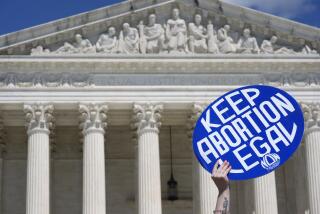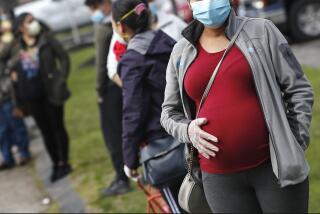Smoking During Pregnancy Drops 33%; Teen Rates Rise
- Share via
WASHINGTON — Smoking during pregnancy dropped by a whopping one-third overall from 1990 to 1999, with the greatest successes occurring among women in their late 20s and 30s, federal health officials reported Tuesday.
But smoking rates for pregnant teenagers climbed during the latter part of the decade, generally mirroring the smoking habits of teens overall, researchers said.
The results were released in a report compiled by the federal Centers for Disease Control and Prevention and marked the first comprehensive look at smoking and pregnancy trends over nearly a decade.
In 1990, when the agency began tracking the statistics, 18.4% of pregnant women smoked at some point during their pregnancy. By 1999, the figure had dropped to just over 12%, a decline of 33%, while women generally showed a small drop in their smoking rate, CDC officials said.
Still, the 12% translates into half a million mothers who continue to smoke during pregnancy.
“We’ve been watching the drops from year to year,” said T. J. Mathews, the author of the report, which was compiled by the CDC’s National Center for Health Statistics. “Of course, even when there’s one woman smoking during pregnancy in the United States, there’s too many.”
Pregnancy Risks Listed in Warnings
Smoking during pregnancy has been linked to serious health consequences, including low birth weight, growth retardation and infant mortality.
“More women are making the right choice and are not smoking during pregnancy, yet too many women . . . [still] smoked while pregnant,” said Dr. Jeffrey P. Koplan, the CDC’s director.
Warnings have long appeared on cigarette packs about the health dangers of smoking during pregnancy, and public health officials attributed the drops to these as well as other persistent anti-smoking messages.
“We’re permeated with it now,” Mathews said. “We used to drive through our neighborhoods and see billboards with the Marlboro man on his horse. Now we see a couple--one saying: ‘Mind if I smoke?’ and the other replying: ‘Mind if I die?’ ”
But for pregnant teenagers, after what the CDC called a “dramatic” decline of 20% in the first part of the decade, their smoking rates climbed by 5% from 1994 to 1999.
The highest rate in 1999, 19%, occurred among women 18 and 19 years old. Pregnant white teenagers had the highest rates, at 30%, representing 1 in 7 of all women who smoked during pregnancy, the agency said.
“We assume that the pregnant teen population isn’t all that different from the teen population as a whole, which continues to smoke,” Mathews said.
On the other hand, the greatest success story occurred among women in their late 20s and 30s, whose rates plummeted 40% during that period.
Health and Human Services Secretary Tommy G. Thompson called the overall results “encouraging,” but he warned that “we must do more to ensure young women understand smoking’s real health risks for them and for their children.”
Overall, women of all racial and ethnic groups were less likely to smoke during pregnancy in 1999 than they were in 1990. However, there were sharp difference in smoking habits among them.
Native American women, for example, had the highest rate of all ethnic groups, 20%, and experienced the smallest reduction. And smoking rates were still high for non-Latina white mothers, 16%, whose rates still dropped by one-quarter, the CDC said.
Women of Chinese descent “were at the very bottom,” with rates of only 0.5%, Mathews said.
Puerto Rican mothers were more likely to smoke while pregnant than any other Latina group, and Hawaiian mothers had higher rates than any other Asian or Pacific Islander women, the CDC said.
There also were differences reflected in educational status. Only 2% of those with four or more years of college smoked during pregnancy in 1999, compared with 29% of those who did not finish high school. Nearly 50% of white women with nine to 11 years of education smoked during pregnancy.
In 1999, 12.1% of women who smoked during pregnancy had babies with low birth weight, compared with 7.2% of women who did not smoke, according to the report.
The CDC said that New York City and the District of Columbia, and Texas, Arizona and Hawaii had the lowest smoking rates among pregnant women in the country--below 8% in 1999.
Female Smoking Rate Dropped Most in ‘80s
The biggest drop in smoking among women of all ages, including those who are older than the usual childbearing years, occurred in the 1980s. Smoking dropped from 27.9% of all women in 1985 to 22.8% in 1990.
Throughout the 1990s the rate stayed pretty much the same, about 22%. The information in the new CDC report is based on 3.5 million birth certificates filed in state vital statistic offices and reported to the CDC through the National Vital Statistics System.
While preparing information for birth certificates, doctors and nurses ask new mothers whether they smoked or drank alcohol during the pregnancy. Their responses are kept confidential and are not recorded on the certificates themselves.
The CDC is in the process of expanding and fine-tuning the questions asked regarding tobacco use to determine more precise smoking patterns during pregnancy, the agency said.
California and South Dakota did not participate in this report; South Dakota has begun collecting statistics for 2000 “and we hope to get California on board soon,” Mathews said.
More to Read
Sign up for Essential California
The most important California stories and recommendations in your inbox every morning.
You may occasionally receive promotional content from the Los Angeles Times.










